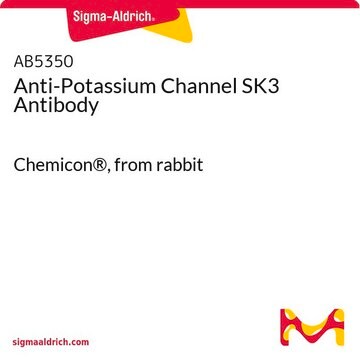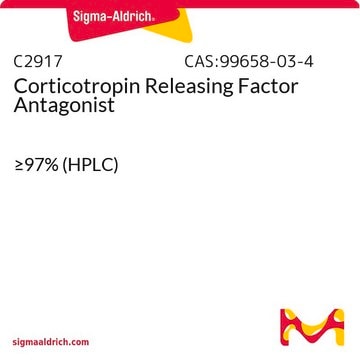おすすめの製品
由来生物
rabbit
品質水準
結合体
unconjugated
抗体製品の状態
affinity isolated antibody
抗体製品タイプ
primary antibodies
クローン
polyclonal
形状
lyophilized powder
化学種の反応性
rat, human
テクニック
western blot (chemiluminescent): 1:200 using rat brain membranes
UniProtアクセッション番号
保管温度
−20°C
ターゲットの翻訳後修飾
unmodified
遺伝子情報
human ... KCNN3(3782)
rat ... Kcnn3(54263)
詳細
The calcium-activated potassium ion channel (KCNN3) is a voltage-independent small-conductance calcium-activated potassium channel. It is abundantly expressed in the brain and central nervous system. Its predominant expression is seen in the hypothalamus. KCNN3 gene is located on human chromosome 1q21.3.
免疫原
synthetic peptide corresponding to amino acids 2-21 of human potassium channel SK3. The epitope is highly homologous in rat.
アプリケーション
Anti-Potassium Channel SK3 (KCa3, KCNN3, SKCa3) antibody produced in rabbit has been used in western blot analysis (1:250) and immunohistochemical staining (1:50).
生物化学的/生理学的作用
Anti-Potassium channel SK3 recognizes the SK3 protein in humans and rats by immunoblotting. Potassium channels contribute to maintaining cell volume, membrane potential, neuronal excitability, and the secretion of transmitters, salt, and hormones. It is extremely sensitive to changes in intracellular calcium levels, which are common during action potentials. KCNN3 helps to determine neuronal firing rates via the after-hyperpolarization. It is a migraine candidate susceptibility gene. Aberrations in the KCNN3 gene may trigger cortical spreading depression (CSD) and trigeminal sensitivity.
物理的形状
Lyophilized at ~0.6 mg/ml from phosphate buffered saline, pH 7.4, containing 1% bovine serum albumin, and 0.05% sodium azide.
免責事項
Unless otherwise stated in our catalog or other company documentation accompanying the product(s), our products are intended for research use only and are not to be used for any other purpose, which includes but is not limited to, unauthorized commercial uses, in vitro diagnostic uses, ex vivo or in vivo therapeutic uses or any type of consumption or application to humans or animals.
Not finding the right product?
Try our 製品選択ツール.
保管分類コード
11 - Combustible Solids
WGK
WGK 2
試験成績書(COA)
製品のロット番号・バッチ番号を入力して、試験成績書(COA) を検索できます。ロット番号・バッチ番号は、製品ラベルに「Lot」または「Batch」に続いて記載されています。
Hannah C Cox et al.
The journal of headache and pain, 12(6), 603-608 (2011-10-28)
The calcium-activated potassium ion channel gene (KCNN3) is located in the vicinity of the familial hemiplegic migraine type 2 locus on chromosome 1q21.3. This gene is expressed in the central nervous system and plays a role in neural excitability. Previous
Pivotal role of the lipid Raft SK3-Orai1 complex in human cancer cell migration and bone metastases.
Aurélie Chantôme et al.
Cancer research, 73(15), 4852-4861 (2013-06-19)
The SK3 channel, a potassium channel, was recently shown to control cancer cell migration, a critical step in metastasis outgrowth. Here, we report that expression of the SK3 channel was markedly associated with bone metastasis. The SK3 channel was shown
Dieniffer Peixoto-Neves et al.
Proceedings of the National Academy of Sciences of the United States of America, 120(31), e2303238120-e2303238120 (2023-07-26)
Endothelial cells (ECs) line the lumen of all blood vessels and regulate functions, including contractility. Physiological stimuli, such as acetylcholine (ACh) and intravascular flow, activate transient receptor potential vanilloid 4 (TRPV4) channels, which stimulate small (SK3)- and intermediate (IK)-conductance Ca2+-activated
Po-Cheng Chang et al.
Journal of the American Heart Association, 2(1), e004713-e004713 (2013-03-26)
We previously reported that IKAS are heterogeneously upregulated in failing rabbit ventricles and play an important role in arrhythmogenesis. This study goal is to test the hypothesis that subtype 2 of the small-conductance Ca(2+) activated K(+) (SK2) channel and apamin-sensitive
S Karppinen et al.
Acta physiologica (Oxford, England), 216(1), 101-111 (2015-06-23)
Activity of early embryonic cardiomyocytes relies on spontaneous Ca(2+) oscillations that are induced by interplay between sarcoplasmic reticulum (SR) - Ca(2+) release and ion currents of the plasma membrane. In a variety of cell types, Ca(2+) -activated K(+) current (IK(Ca)
ライフサイエンス、有機合成、材料科学、クロマトグラフィー、分析など、あらゆる分野の研究に経験のあるメンバーがおります。.
製品に関するお問い合わせはこちら(テクニカルサービス)








